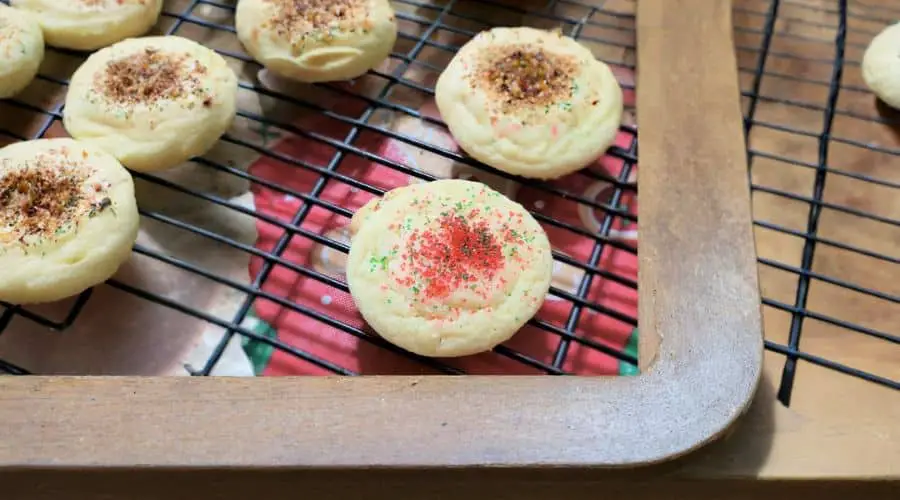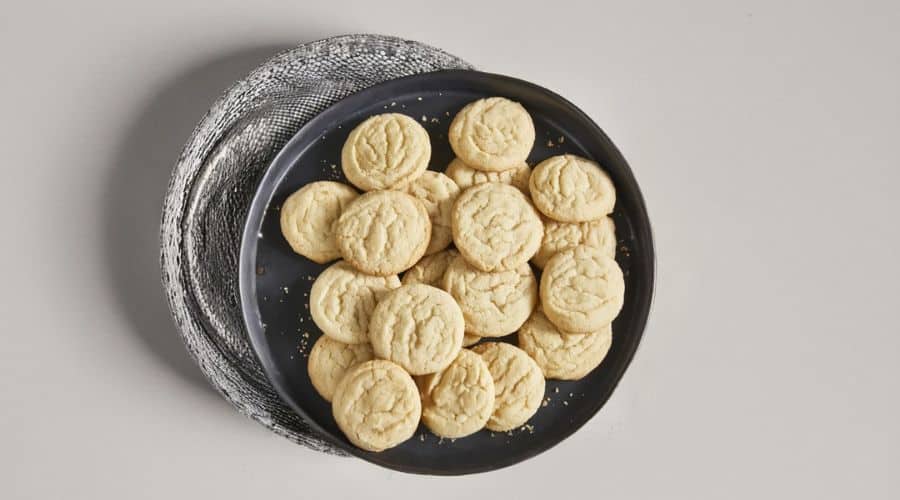This classic sugar cookie recipe stands out for its perfect balance of simplicity and flavor, making it a go-to favorite for home bakers of all skill levels.
Crafted from basic pantry staples like butter, flour, and sugar, it delivers buttery, tender cookies with just the right hint of sweetness.
While not specifically designed as a health-focused recipe, it offers a moderate calorie count per cookie, with good-quality fats from butter that provide richness and satisfaction.

Its straightforward preparation makes it ideal for everyday baking—whether you’re whipping up a batch for a quick treat, holiday gathering, or meal prep for dessert.
The recipe’s versatility also invites creativity through decoration or flavor additions, ensuring it fits various occasions and tastes.
Its quick mixing and short bake time mean you can enjoy fresh homemade cookies in under 30 minutes, a perfect blend of convenience and indulgence.
Must-Have Tools for Perfect Results
Electric Hand Mixer
Essential for creaming butter and sugar to a smooth, fluffy consistency, this tool speeds up mixing and ensures even incorporation of ingredients. It’s a versatile kitchen staple, perfect for whipping creams, beating eggs, and mixing batters.
Measuring Cups and Spoons
Accuracy is key in baking, and these tools guarantee precise measurement of flour, sugar, and leaveners for consistent cookie texture every time. They’re indispensable for any home cook striving for perfect results.
Mixing Bowls
A set of durable mixing bowls provides ample space for combining wet and dry ingredients separately, allowing for easy, mess-free preparation. Their multi-purpose design is useful for everything from marinating to tossing salads.
Baking Sheets
Flat, sturdy baking sheets provide an ideal surface for evenly baking cookies with golden edges. High-quality sheets ensure even heat distribution and easy cleanup, making them essential for all baking adventures.
Cooling Rack
This tool allows cookies to cool evenly after baking, preventing sogginess and preserving crisp edges. It’s a must-have for maintaining texture and quality in baked goods.

Sugar Cookies
Equipment
- 1 Electric hand mixer
- 2 Mixing bowls (medium and large)
- Measuring Cups and Spoons
- 2 Baking sheets
- Cooling rack
Ingredients
- 2 ¾ cups all-purpose flour
- 1 teaspoon baking soda
- ½ teaspoon baking powder
- 1 cup 2 sticks unsalted butter, softened
- 1 ½ cups granulated sugar
- 1 large egg
- 1 teaspoon vanilla extract
Instructions
- Prepare Your Ingredients and Workspace: Begin by gathering all your ingredients and kitchen tools. This helps streamline the process and avoids last-minute scrambling. Measure out 2 ¾ cups of all-purpose flour, 1 teaspoon of baking soda, ½ teaspoon of baking powder, 1 cup (two sticks) of softened unsalted butter, 1 ½ cups of granulated sugar, 1 large egg, and 1 teaspoon of vanilla extract. Ensure the butter is softened to room temperature, which means it should be soft enough to press gently but not melted. This is key for proper creaming and smooth dough texture. Preheat your oven to 375°F (190°C) to get it ready for baking. Line your baking sheets with parchment paper or a silicone baking mat to prevent sticking and promote even baking.
- Combine Dry Ingredients Thoroughly: In a medium-sized mixing bowl, add the measured flour, baking soda, and baking powder. Use a whisk or fork to thoroughly blend these dry ingredients. This ensures that the leavening agents are evenly distributed throughout the flour, which is crucial for the cookies to rise evenly and have a consistent texture. Set this bowl aside for later use.
- Cream Butter and Sugar Until Fluffy: In a large mixing bowl, add the softened butter and granulated sugar. Using an electric hand mixer on medium speed, beat these together until the mixture turns pale, creamy, and fluffy. This process should take approximately 3 to 5 minutes. The creaming of butter and sugar is essential as it incorporates air into the mixture, resulting in light, tender cookies with a delicate crumb. Be sure to stop a couple of times to scrape down the sides of the bowl with a rubber spatula, ensuring no butter or sugar remains unmixed.
- Incorporate Egg and Vanilla Extract Smoothly: Once your butter and sugar mixture is light and fluffy, add the large egg and 1 teaspoon of vanilla extract. Beat on medium speed until fully combined, scraping down the bowl again if necessary. The egg adds moisture and helps bind the dough ingredients together, while the vanilla extract enhances the cookie’s flavor with a sweet, aromatic note. Mixing thoroughly at this stage ensures a uniform dough without pockets of egg or vanilla.
- Gradually Add Dry Ingredients to Wet Mixture: Reduce your mixer speed to low and begin adding the dry flour mixture in small batches to the butter mixture. This gradual addition prevents flour from flying out of the bowl and allows the ingredients to combine evenly without overworking the dough. After each addition, mix gently just until the flour is fully incorporated. Over-mixing can develop gluten in the flour, which could lead to tough cookies. Once all the flour mixture is blended in, stop mixing and give the dough a final gentle stir with a spatula to make sure there are no streaks of flour left.
- Shape Dough into Uniform Balls: Using your hands or a small cookie scoop, portion the dough into walnut-sized balls—about 1 to 1 ½ inches in diameter. Roll each piece gently between your palms to create smooth, even balls. Place the dough balls at least 2 inches apart on your prepared baking sheets. Spacing them properly allows the cookies to spread evenly without sticking together during baking.
- Bake Until Edges Are Lightly Golden: Place the baking sheets on the middle rack of your preheated oven. Bake the cookies for 8 to 10 minutes, watching closely toward the end. You’re aiming for edges that turn a delicate golden brown while the centers remain slightly soft. This timing ensures a perfect balance of crispness and chewiness. Avoid over-baking, as this can dry out the cookies.
- Cool Cookies Properly for Best Texture: Once baked, remove the sheets from the oven and let the cookies cool on the baking sheets for about 3 to 5 minutes. This brief cooling allows the cookies to firm up slightly, making them easier to transfer. Then, carefully use a spatula to transfer the cookies to a wire cooling rack. Allow them to cool completely on the rack, which prevents steam from softening the bottoms and helps maintain a crisp edge with a tender center.
- Optional – Decorate and Serve: If desired, once the cookies are fully cooled, you can decorate them with your favorite sugar cookie frosting and sprinkles to add color and festive flair. This step is optional but enhances presentation and flavor, especially for special occasions. Serve the cookies fresh, or store them in an airtight container at room temperature for several days to enjoy later
Notes
Chef’s Secrets: Mastering Cookie Texture and Flavor
Achieving the ideal sugar cookie texture hinges on how you handle the butter and sugar creaming step.
Beating these ingredients long enough to create a fluffy, aerated mixture introduces tiny air pockets, which give the cookies a tender crumb and delicate rise.
Avoid overworking the dough once flour is added, as excessive mixing develops gluten, resulting in tougher cookies. T
o add extra flavor depth, try substituting half the vanilla extract with almond extract or adding a pinch of salt to balance the sweetness.
For uniform baking, use parchment paper or silicone mats on your baking sheets, which help prevent sticking and promote even heat distribution.
Experimenting with dough chilling times can also improve texture and flavor, making this recipe flexible for your preferred cookie style.
Serving Suggestions: Perfect Pairings And Presentation
Sugar cookies are incredibly versatile and pair beautifully with a variety of accompaniments.
For an elegant touch, serve them alongside a cup of hot tea or freshly brewed coffee to balance their sweetness.
They also complement festive occasions when decorated with colorful royal icing or buttercream frosting and sprinkles.
To add a playful twist, sandwich two cookies with a layer of chocolate ganache or flavored cream cheese frosting.
For casual gatherings, arrange the cookies on a platter with fresh fruit and nuts to add contrasting textures and flavors.
Whether enjoyed as a simple snack, dessert, or gift, these sugar cookies offer a crowd-pleasing treat that fits any occasion.
Storage Tips: Keeping Cookies Fresh Longer
To maintain the freshness and texture of your sugar cookies, store them in an airtight container at room temperature for up to one week.
If you’ve decorated the cookies with frosting, layer them carefully with parchment or wax paper between to prevent sticking and smudging.
For longer storage, freeze baked cookies in a single layer on a baking sheet until firm, then transfer to a freezer-safe container or zip-top bag with an additional layer of foil for protection.
Frozen cookies can be kept for up to two months and thawed at room temperature before serving.
Cookie dough balls can also be frozen before baking — simply thaw in the refrigerator overnight and bake as usual for freshly baked cookies anytime.
Frequently Asked Questions: Common Cookie Queries Answered
1. Can I substitute butter with margarine or shortening?
While margarine or shortening can be used, butter provides superior flavor and texture, giving the cookies a rich taste and tender crumb. If substituting, expect slight changes in flavor and spread.
2. Why are my cookies spreading too much during baking?
Overly soft butter, insufficient flour, or too much sugar can cause spreading. Ensure butter is softened but not melted, measure flour accurately, and chill dough if needed to reduce spreading.
3. Can I make these cookies gluten-free?
Yes, using a gluten-free all-purpose flour blend that includes xanthan gum works well. Adjust baking time slightly as gluten-free flours can affect texture and moisture.
4. How do I get crisp edges but soft centers?
Bake the cookies just until the edges turn golden while the centers still look slightly underbaked. They will firm up as they cool, offering a perfect contrast in texture.
5. Can I add mix-ins like chocolate chips or nuts?
Absolutely! Gently fold in chocolate chips, chopped nuts, or dried fruit after adding the flour mixture for added texture and flavor. Keep portions moderate to maintain cookie shape.
This recipe is inspired by allrecipes and has been carefully refined to enhance clarity, streamline preparation steps, and ensure accurate results. We’ve also included health benefits, nutritional highlights, and Must-Have Tools to help you get the best results every time you cook.


